Donald Herbert Durant Barrett
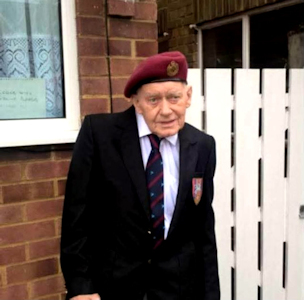
Details below received from Donald's Grandson, Sean Impett
In November 1944, Donald was conscripted under the National Service Acts, receiving his enlistment notice as Britain intensified its final push toward victory. What became of the RAF air crew duty offer is unknown.
The enlistment notice below, from the BARRETT family archives, offers rich insight into the life and times of Donald Herbert Durant BARRETT on the 8th of November 1944.
He was conscripted into the Territorial Army and instructed to report to Squires Gate Camp, Lytham St. Annes on the 16th of November 1944. His orders directed him to present himself to the C.S.O. of the 9th Kings Battalion— the 9th Kings Battalion was primarily involved in home defence and training duties within the UK.
We know from a personal diary entry made by Donald that he joined the 25th Platoon in C Company of the 9th Kings Battalion.
Alongside his notice, he received a Postal Order for four shillings as an advance on service pay, and a Travel Warrant to cover his journey north.
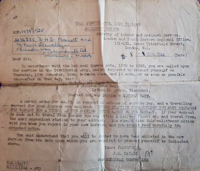
Notice of Enlistment
Click to view a larger version
It is now the 16th of November 1944, and Donald is at Squires Gate Camp in Lytham St. Annes to enlist in the Territorial Army.
Donald’s personal details can be seen on the form below.
He would have been slightly below average height and weight for a 19-year-old British male in 1944—but still well within the range accepted for military service.
We can see that Donald carried two scars, one on his outer left wrist the other on his upper right arm.
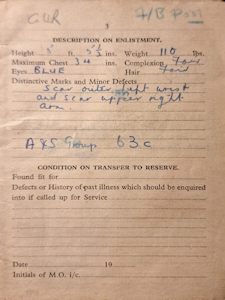
Description of Enlistment
Click to view a larger version
In the middle of the Description on Enlistment form is the code A&S Group 63C.
Introduced in 1944, the Age and Service Group (A&S Group) system was designed to manage the orderly release of servicemen after the war. Each man was assigned a group number based on:
• Age (as of the 1st of January 1947)
• Length of service (from date of enlistment or conscription)
• Group 63 would typically correspond to men born around 1925, like Donald.
• The letter suffix (e.g., C) often denoted a subcategory or administrative batch—sometimes related to branch, role, or processing centre.
• Men in Group 63 were scheduled for release in the early months of 1947, depending on their role and unit needs.
The 261st (Airborne) Field Park Squadron, Royal Engineers – Bulford Camp
A diary entry confirms that Donald was in the 9th Kings Battalion, Squires Gate Camp, Lytham St. Annes until the 28th of January 1945 when he was transferred to the 261st (Airborne) Field Park Squadron, Royal Engineers — a specialist unit tasked with supporting airborne operations through engineering logistics, equipment handling, and technical support.
Stationed at Bulford Camp on Salisbury Plain, Donald would have been part of the post-war transition as the British Army shifted from active operations to demobilisation and reorganisation.
We know from Donald’s discharge papers that he was a Driver Mechanic and this is probably the role he played in the 261st when at Bulford Camp.
The 261st (Airborne) Field Park Squadron, Royal Engineers – Norway
In May 1945, the 261st Field Company was deployed to Norway as part of Operation Doomsday—the Allied mission to oversee the German surrender and help stabilise the country after years of occupation.
While stationed in Norway, Donald befriended Syd Briton, a fellow member of the 261st. Years earlier, Syd had volunteered alongside 34 other Airborne Sappers for what would become a tragic and near-suicidal mission: Operation Freshman.
The plan, launched in November 1942, was to fly two gliders carrying 35 Airborne Engineers into Telemark to destroy Nazi Germany’s stockpile of heavy water (deuterium oxide)—a critical component in their atomic research.
Just two days before departure, Syd twisted his ankle and was declared unfit for the operation. It was a twist of fate that likely saved his life. The gliders crashed in severe weather; the surviving engineers were captured and later executed by the Gestapo.
The more famous follow-up raid—immortalised in film as The Heroes of Telemark—took place on the night of the 27th – 28th of February 1943.
The target was the Vemork hydroelectric plant near Rjukan, which produced the heavy water essential for nuclear reactor moderation and Germany’s atomic ambitions.
A team of Norwegian commandos, trained in Britain, parachuted into the mountains and joined an earlier reconnaissance group.
They skied across unforgiving terrain, infiltrated the plant via a ravine and railway line, and placed explosives on the production cells.
The raid destroyed vital equipment and over 500 kilograms of heavy water, dealing a decisive blow to Germany’s nuclear program. It remains one of the most celebrated acts of sabotage in the Second World War.
Donald was awarded the certificate of thanks from the Norwegian people for his part in the liberation of Norway from Nazi Germany on the 8th of May 1945. (see image below)
The certificate is signed by Crown Prince Olav of Norway, who later became King Olav V in 1957 following the death of his father, King Haakon VII.
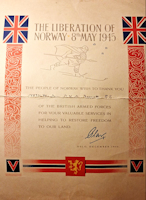
Certificate of Thanks
Click to view a larger version
The 6th Airborne) Field Park Squadron, Royal Engineers – Palestine
A diary entry by Donald dated the 1st of January 1946 reveals that he was ‘put on draught at Halifax for overseas.’ The phrase was standard military parlance, indicating assignment to a group of personnel scheduled for movement—typically by ship or train—to an overseas posting.
Donald was posted to Alexandria in Egypt where, on the 26th of January 1946, he made another personal entry:
‘Came to the conclusion that I don’t like the M.E.F. and never will.’
The M.E.F., or Middle East Forces, oversaw logistics, training, and deployments for units stationed in or passing through the region, including airborne and engineering detachments. Donald doesn’t elaborate on the source of his dislike, but the tone suggests a quiet disillusionment—perhaps with the climate, the command structure, or the ambiguous nature of postwar operations in the region.
Another entry for the 26th of January 1946 may have led to difficulties for Donald;
‘Failed to salute the CO’
There is no record to determine whether the CO is from the Royal Engineers or from the M.E.F., either way failing to salute a CO was considered a breach of military discipline and respect. The outcome would depend on context, intent, and the officer’s disposition.
Donald later earns a visit home before returning to the Middle East, this time to Palestine with the 6th (Airborne) Field Park Squadron, Royal Engineers.
This is Donald’s itinerary for his posting to;
6th April 1946 – Left Victoria Station at 07:24 arriving Newhaven 11:15
7th April 1946 – Left Newhaven at 11:00 arriving Dieppe 15:30
9th April 1946 – Left Dieppe at 18:30 by train bound for Toulon
Donald is then transported by ship from Toulon through the Staits of Messina and on to Alexandria for deployment in Palestine.
18th April 1946 - Disembarked at Alexandria 15:15
19th April 1946 – Left Alexandria at 23:15 arrived in Ismailia 06:00
20th April 1946 – Left Ismailia at 08:00 arrived at camp in Palestine 18:00
Ismailia is situated on the west bank of the Suez Canal, British forces, including Royal Engineers, were stationed there for logistics, communications, and canal security.
The journey to camp in Palestine took ten hours, the camp may have been located in Gaza, Deir al Bala, Beersheba or Sarafand.
The most likely location being Gaza, it was a major British military presence and a base for Royal Engineers and others.
On the 22nd of July 1946, just three months after Donald arrived in Palestine, a major terrorist attack on The King David Hotel occurred. It was carried out by Irgun, a Zionist paramilitary group. The attack resulted in 93 deaths, including British officials and soldiers. The British authorities responded with mass arrests, curfews, and search operations targeting Jewish communities and underground groups. Tensions between the British and Jewish populations escalated sharply, with retaliatory violence and public protests.
Just weeks earlier, the British had launched Operation Agatha on the 29th of June 1946, arresting thousands of Jews and raiding settlements. The bombing of the King David Hotel was partly a response to that crackdown, and in turn, it triggered even harsher British measures:
• Martial law in parts of Palestine
• Censorship and travel restrictions
• Riots and demonstrations, especially in Jerusalem and Tel Aviv
Immediately after the explosion at the King David Hotel, Donald and his Royal Engineers comrades were hurried to the scene with heavy lifting equipment to assist in rescue operations.
They faced hostile crowds, roadblocks, and stone-throwing as they tried to reach the hotel. Once on site, they worked in three rotating shifts, often 16 hours on, 8 hours off, for several days—driven by the hope of finding survivors.
While not frontline riot police, Donald and the Royal Engineers were part of the 6th Airborne Division, which took on internal security duties across Palestine. These included:
• Guarding convoys and installations
• Patrolling towns and enforcing curfews
• Supporting cordon-and-search operations
As casualties mounted and tensions escalated, engineers were sometimes reassigned or absorbed into roles vacated by fallen troops, especially in logistics and infrastructure support.
Late in 1946 the 6th (Airborne) Field Park Squadron, Royal Engineers were renamed the 249th (Airborne) Field Park Squadron, Royal Engineers, reflecting broader reorganisations within the British Army's airborne forces. Later in 1947, the 249th was redesignated again as the 147th (Airborne) Park Squadron, the 147th were then redeployed to the northern sector of Palestine.
The 147th were part of the 6th Airborne division, the division gradually withdrew its units throughout 1947 and 1948, with the last troops leaving in May 1948, after which the division was disbanded.
Demobilisation
Donald Herbert Durant BARRETT was formally demobilised from military service on the 16th of January 1948. The official discharge document, reproduced below from the BARRETT family archives, confirms his enlistment date as the 6th of November 1944 and records his rank as Lance Corporal. In the British Army, a Lance Corporal typically serves as second-in-command of a section or holds a specialist role—both requiring leadership and technical competence.
Donald’s trade was listed as Driver Mechanic, a dual role that demanded both mobility and mechanical expertise. He was not merely tasked with transporting equipment; he bore responsibility for the maintenance, repair, and operational readiness of the vehicles that sustained the squadron’s momentum. Within an airborne engineering unit—where timing, terrain, and logistics were critical—this meant working under pressure, often in austere conditions, to ensure that lorries, motorcycles, and specialized transport remained fit for purpose.
His unit is recorded on the demobilisation form as 6 Field Park Squadron, despite the fact that by 1948 it had already been redesignated as the 249th Airborne Park Squadron and later to the 147th. This discrepancy may reflect an administrative lag, the continued use of the original unit name in personnel records, or simply a nod to the unit in which Donald spent the most significant portion of his service.
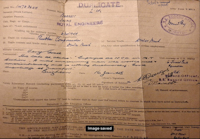
Demobilisation Form
Click to view a larger version







